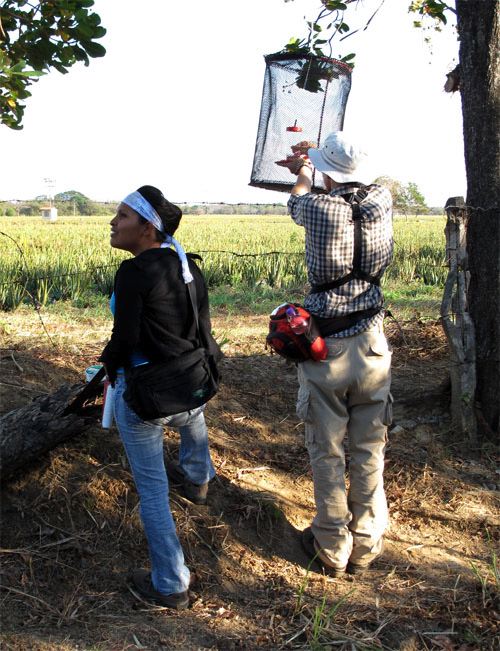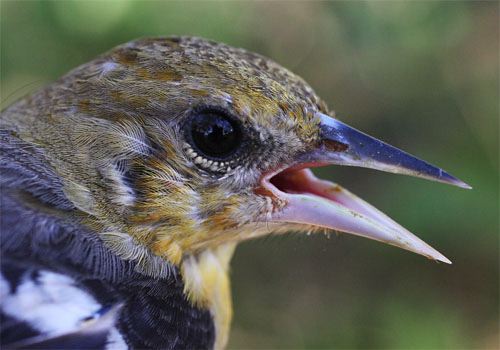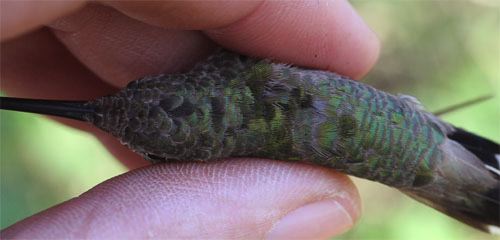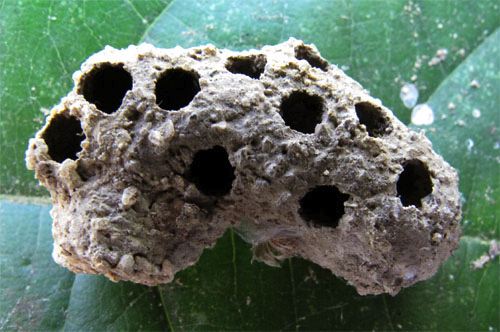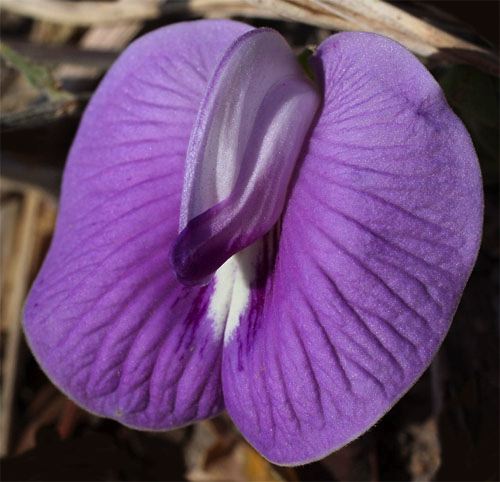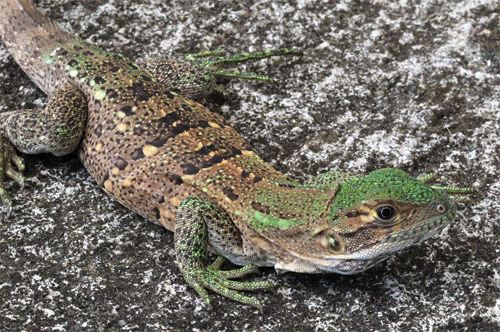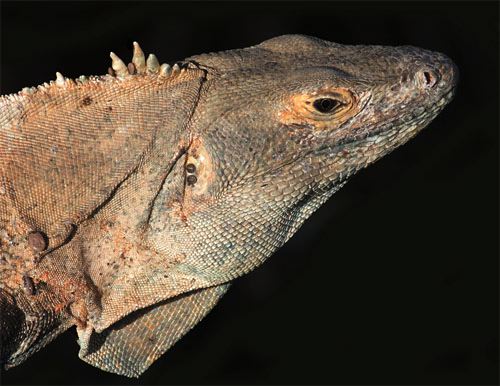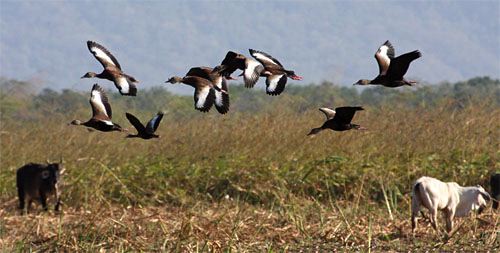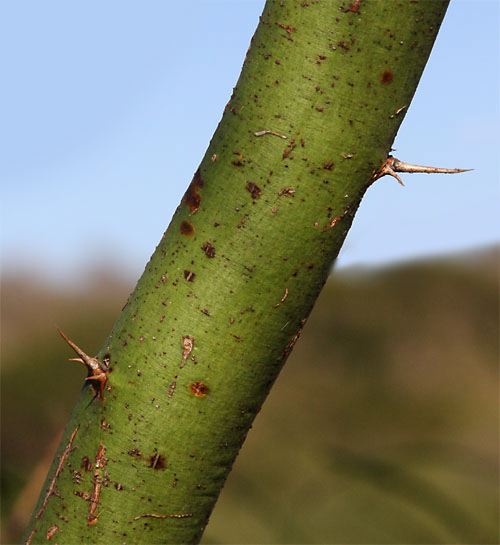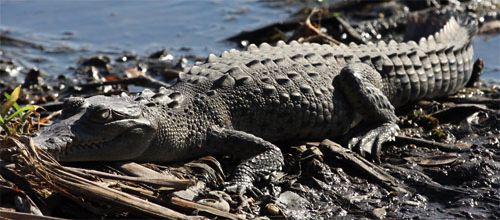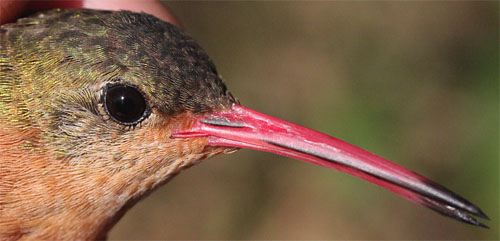|
|
|||
|
(Back to Preceding Week; on to Next Week) |
|
COSTA RICA PORTFOLIO 2010: Each winter through Operation RubyThroat we depart Hilton Pond Center and meet up in Costa Rica with one or more groups of citizen scientists from the U.S. and Canada, with the intent of learning as much as we can about Ruby-throated Hummingbirds (RTHU) on their wintering grounds in Guanacaste Province. The expeditions, organized through Holbrook Travel, always include Ernesto Carman Jr.--a tico who in the early part of this decade discovered concentrations of ruby-throats in Aloe Vera plantations around Liberia. Ernesto has been our knowledgeable, dependable, and industrious in-country guide, interpreter, and friend ever since, and this year he brought along Elaida Villanueva Mayorga--his new bride and a young tica quite familiar with our hummingbird research. Ela, Ernesto, and Operation RubyThroat trip leader Bill Hilton Jr.--known as the "Omega Group"--traveled to Guanacaste a week early and stayed another several days after the six-member "20-Tenners" crew departed. During the full three-week span the collective efforts of everyone involved helped us make new discoveries about RTHU winter behavior, summarized in last week's photo essay. Our current "This Week at Hilton Pond" installment is a portfolio of people, places, and things we encountered in far-away Costa Rica in January-February 2010, so please scroll down for a look at what we experienced.
All text & photos © Hilton Pond Center
All text & photos © Hilton Pond Center Our primary reason for being in Guanacaste Province, Costa Rica was, of course, to observe, capture, and band Ruby-throated Hummingbirds on their wintering grounds. Most years we use mist nets to snare hummers, but in 2010 we decided to also try a few Dawkins traps baited with sugar water feeders (above); the traps worked very well catching ruby-throats last fall at Hilton Pond Center, so Ernesto hung one of these contraptions on the perimeter of commercial aloe fields belonging to Pelón (formerly Carrington Labs' Finca Sabila). Meanwhile, Ela watched for hummers in surrounding trees. Unfortunately, strong winds around Liberia blew the traps around so much they were ineffective.
All text & photos © Hilton Pond Center Numerous Neotropical migrants besides Ruby-throated Hummingbirds frequent Pelón's aloe fields in Guanacaste--including adult male Baltimore Orioles (above). Tennessee Warblers, Baltimore and Orchard Orioles, and several NON-migratory hummers also find aloe flowers to be a rich source of carbohydrates. The close-up image of an immature (second-year) female Baltimore Oriole (below) shows her sharply pointed bill that is adapted for, among other things, taking nectar from short, tubular flowers. (This bill--as we know from painful experience--can also puncture the bander's skin if an in-hand oriole starts pecking like a woodpecker!)
All text & photos © Hilton Pond Center
All text & photos © Hilton Pond Center One of the first Ruby-throated Hummingbirds we netted at Pelón this year was a "young" female (above). We called her a second-year bird that must have hatched in 2009; this determination was made because new body feathers she was bringing in were much darker and better-formed than the pale, brown-edged ones she acquired last year as a nestling. Differentiating immatures from adults among male RTHU is easy; it may be next-to-impossible to age most females conclusively using plumage characteristics.
All text & photos © Hilton Pond Center Beneath the banding table at Pelón we found this interesting artifact--a lump of hard soil with numerous circular openings. We're guessing this is the mud nest of some wasp species and that the holes are exits through which a new generation of insects emerged after spending egg, larval, and pupal stages therein. (NOTE: As with other unidentified organisms on this page, if you think you know specifically what's depicted in a photo, please send a note to INFO.)
All text & photos © Hilton Pond Center Even though our main effort in the field in Costa Rica was to band Ruby-throated Hummingbirds, we also devoted considerable time to looking at local flora--especially flowers visited by RTHU. The 1.5"-diameter purple blossom above, which we believe is one of the Butterfly-Peas (Clitoria sp.), was growing among our net lanes at Pelón. We don't think it is a hummingbird flower, although some peas are. (NOTE: Our next installment of "This Week at Hilton Pond" will be the third and final one about our 2010 Costa Rica expedition. It will include photos and a full discussion of Neotropical plants visited--and possibly pollinated by--Ruby-throated Hummingbirds.)
All text & photos © Hilton Pond Center Members of the Tyrant Flycatcher Family (Tyrannidae) abound in Costa Rica, and a bunch of them are yellow-breasted. Western Kingbird and Tropical Kingbird are quite similar, but the latter--depicted above and below--has a darker back and a MUCH heavier bill. Flycatchers are among those birds with well-developed "rictal bristles"--stiff, hair-like feathers that project from the base of the bill. Some folks believe these structures funnel insects into a bird's gape; we think they also may serve to protect an avian predator's eyes while it's trying to swallow a squirmy beetle or bug.
All text & photos © Hilton Pond Center
All text & photos © Hilton Pond Center Iguanas are everywhere in Costa Rica but--despite the appearance of the jade-colored youngster above--in Guanacaste Province the Green Iguana, Iguana iguana, is virtually absent. Instead we find lots of Black Iguanas, Ctenosaura similis. Ctenosaurs start out green (above) and gradually become brown; older males (below) develop short dorsal spines and a big dewlap, the loose fold of skin on the throat. These heavy-bodied big lizards--up to five feet long--are amazingly agile, especially in trees where they spend a great deal of time sunning.
We photographed this adult male Ctenosaur (above) on a sun-drenched boardwalk in late afternoon at Palo Verde National Park south of Liberia. He was almost oblivious to us--and apparently to the surprising number of ticks that were attached in his ear (at right in the close-up photo below) and elsewhere on his body. Some of these ectoparasites were quite distended with blood, while others were still small and at the "seed tick" stage. We counted five ear ticks and at least a half-dozen more scattered about. (In the photo above there are even two more ticks among the dorsal spines.)
All text & photos © Hilton Pond Center
All text & photos © Hilton Pond Center Palo Verde National Park, visited by the Omega Group before the 20-Tenners arrived, is a vast 32,000-acre protected wetland along the Tempisque River at the north end of the Bay of Nicoya. In midwinter much of the water dries up and local farmers are permitted to graze horses and cattle (above) that, in turn, keep cattails from taking over the marsh. Receding waters also tend to concentrate huge flocks of waterfowl and wading birds, including Black-bellied Whistling Ducks (above and below).
All text & photos © Hilton Pond Center Along with the whistling ducks in the photo above are two Black-necked Stilts (at right), an adult Jaçana (lower left) and an immature Jaçana (above left). We also saw, among other waders, several Tricolored Herons, Little Blue Herons, Snowy Egrets, Limpkins, Roseate Spoonbills, Great Egrets, and--of course--Cattle Egrets.
All text & photos © Hilton Pond Center It's hard to tell just how many Black-bellied Whistling Ducks are standing around in the Palo Verde wetlands until a Peregrine Falcon buzzes through. When that happens, enormous flocks of ducks lift skyward (above) and wheel around for several minutes before settling back down in the marsh. Anyone care to count?
All text & photos © Hilton Pond Center Palo Verde National Park is so-called because it is home to a common tropical tree bearing that name. Parkinsonia aculeata (formerly Cercidium sp.), the Mexican Palo Verde. Palo verde literally means "green stick," appropriate because this plant can photosynthesize through its chlorophyll-laden trunk. Found widely from the southern U.S. into Central America, it is the state tree of Arizona.
All text & photos © Hilton Pond Center The Mexican Palo Verde has big clusters of yellow flowers (above) that branch from among thorny stems and leaves with hard little knobs along their margins. It is drought-tolerant and a perfect plant for arid Guanacaste (AND Arizona). All text & photos © Hilton Pond Center
All text & photos © Hilton Pond Center By far the biggest reptile in Palo Verde National Park is the American Crocodile, Crocodylus acutus (above). Adult males can grow to 13 feet in length and weigh more than 800 pounds--a creature to be treated with caution and respect. The individual in the photo above was an immature only about three feet long, but we could tell from the glint in its pale eye it would probably take a nip out of us if we wandered too close.
All text & photos © Hilton Pond Center After a week of preliminary work by the Omega Group, our six 20-Tenners flew in from various parts of the U.S.; first stop leaving the airport was the Laurel House (above), a fine open-air restaurant that served our crew their first traditional Costa Rican meal.
|

